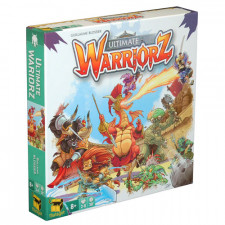Ultimate Warriorz (2016 Edition) Review
on Dec 15, 2016
If there’s one thing that’s been missing from my life it’s a game that allows me to clack some beer bottles together while crooning “Waaaarrrriorrrz, come out to pla-ay!†If you were expecting a review not full of quotes from the ’79 Walter Hill flick “The Warriorsâ€, then you came to the wrong place.
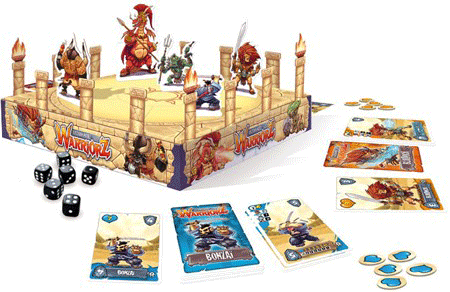
Can you dig it?
Ultimate Warriorz is a Matagot release, which means it’s gorgeous. You have huge monster standees that tower over the fantastic 3D battleground. Whoever had the idea of flipping the box upside down and sticking some cardboard pillars around the edge flaps is a genius. Beautiful games with inviting themes draw people in, and the in-your-face light gameplay will keep you there.
This is a 10 minute brawl that works with 2-8 cheering hooligans throwing trash-talk above the din of the cries from the weak. You each control a unique character of varying size and culture that possesses an asymmetrical deck. The large dragon tends to move slower and hit harder. The quick Dwarf Samurai has an extremely high defense but much less health. The Goblin Shaman boasts great range capabilities but slightly weaker melee ones. Flavor and identity are baked right in with fantastic results.
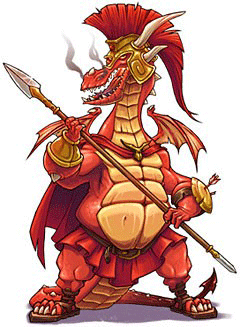
“Well, good! I’m sick of runnin’ from these wimps!â€
Undeniably this occupies the same niche and weight of the ubiquitous King of Tokyo. It’s a light game that can be taught to anyone and quickly picked up. Beyond genetic asymmetry, this design separates itself from the Kaiju in the room by bringing conflict to the foreground. Many people voice displeasure in the passive play that can result in its peer as someone sits back outside of the Japanese metropolis collecting points for a dull victory. In Ultimate Warriorz you have to spill blood – and I’m talking the Orc, Minotaur, Halfling, and even Tree variety.
Each turn players simultaneously select a card from their character deck to play face down on the table. Someone counts out initiative and cards are revealed and played when their number is called. On your turn you may be able to move and attack at ranged or melee. The dice pools used for attacking require rolling six-siders to equal or exceeding the defense value on the defender’s last played card. It’s simple, direct, and engaging.
When you nail the poor bugger you take some of his life tokens and flip them over to show prestige points. The winner is the last man/woman/beast standing or the person with the most prestige at the end of seven rounds. The trick here is that you don’t get the card back that you played for the round so your options wane and choices get more agonizing as the game progresses. As opposed to simply re-rolling piles of Yahtzee dice, you’re selecting cards to play based on initiative, defense, and offensive capabilities. You can certainly play three sheets to the wind but strategy and decisive tactics will help you prove more successful than the fool who can barely balance on his chair.
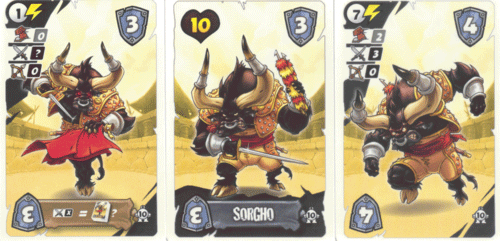
“You Warriors are good. Real good.â€
There’s a brilliant little mechanism here where the first wound each character suffers is worth a strong three prestige points as opposed to the normal value of one. What this does is strongly incentivize spreading out damage initially and sharing the pain. It’s clever and it delivers like your grandma’s lasagna.
This also helps alleviate the common problem in this style of game where players arbitrarily attack each other, unsure of who to target. The increased reward of the first strike, varying defense, and urge to beat up on the leader all help to provide a small bit of meat to that decision tree. This isn’t a meat tree like Terra Mystica, but the thought process and investment is slightly higher than that of King of Tokyo.
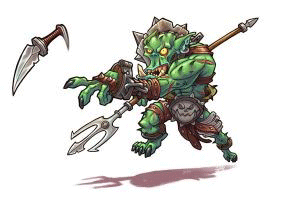
“See that guy? Over there! He’s after you, and he’s got some guys with him.â€
While the huge boon for a first strike helps to smooth things out, it doesn’t quite do enough to make up for the inequalities of size in this game. Larger characters tend to have much higher health but much lower defense than the mite sized heroes. We’re talking a dragon with 16 life points but average 3-4 defense. Meanwhile you got a small time Dwarf wielding a Katana with reckless abandon and only boasting a puny five life, but you need to roll a five or six to hit the little dude.
This seems roughly balanced, and it kind of is, but what happens is the odd psychological inclination for people to attack the big honking fire breather. By only needing a three or above to hit you are guaranteeing more points on your attack and overall more effectiveness.
What tends to fuzzily balance the scales is the fact that near end game players will suddenly realize if they all kill the dragon then they will have to turn on each other and it may be too late to finish off their enemies. Inevitably an ankle biter lashes out and starts attacking a buddy before the large scaly critter is impaled and all hell breaks loose. This is when the game really opens up and brings the fun but it can be somewhat frustrating if you’re the sole big guy in the ring and everyone wants to pile it on.
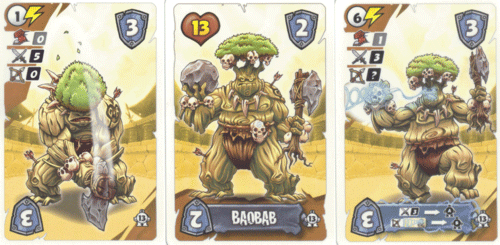
“Be lookin’ good, Warriors. All the way back to Coney.â€
I would still say that the larger guys have a rough go of it and succeed slightly less often. It’s just something you will have to live with or balance out yourself with creature selection, but I can tell you that this game is absolutely worth that little blemish. It eliminates turtling, brings asymmetry, and provides for deeper play. I’m not quite ditching the Kaiju dice roller, but it might find itself just a little farther back on my shelf. Laughs and smiles are what it’s all about and a Halfling swashbuckler battling a Minotaur matador will have the corners of your mouth turning up.

 Customer Support
Customer Support  Subscribe
Subscribe 




 Account
Account  Wishlist
Wishlist 
